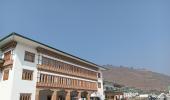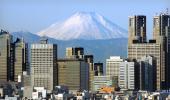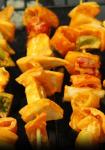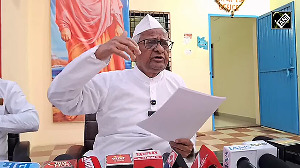Stunning landscapes, natural beauty, clean beaches, cultural wealth, mouth-watering food, shopping options, safety for solo travellers, warm hospitality, easy visas, and connectivity make Vietnam a must-visit destination, discovers Ramesh Menon.

Hundreds of excited tourists line up on both sides of a narrow street where a railway track cuts through. On both sides of the track are small shops selling drinks and eatables, some of which are full-fledged restaurants with a rich fare.
All of them are colourfully lit up with paper and silk lanterns. Some perch on tiny stools at these makeshift cafes, sipping egg-whisked coffee, nibbling on grilled meat, or tearing into crusty sandwiches.
Others flatten themselves against the walls, hearing the train horn blaring. In a few seconds, it is thundering past with the bogies just inches from their wide-eyed faces.

There is panic on some faces; others scream in excitement as adrenaline surges when the train rushes past.
This is Hanoi's now world-famous Train Street in Vietnam. "It was the most frightening experience of my life," said Jane, a tourist from the US, rolling her eyes with a nervous laugh.
Seconds after the train vanishes around the bend, life resumes as if nothing happened -- tourists spill back onto the tracks, posing for Instagram reels.
Others get back to sipping beer and talking about how crazy it was. Some have never experienced something like this ever before.

Vietnam hopes to welcome 18 million visitors in 2025 as it is the new tourist paradise.
Foreign tourists are coming in droves as it is one of the most affordable destinations in the world. Last year, over 17.6 million tourists explored the country.

Among them were over 500,000 Indians.
With direct flights, food choices, easy e-visas, and plenty to explore all over the country, Vietnam is emerging as a favourite of Indians wanting to sample history, serenity and style at affordable prices.
The most significant draw was from South Korea, with 4.5 million tourists, followed by China, with 1.29 million.
There is good reason for tourist numbers to swell year after year: Locals are hospitable, and hotels cater to both high and low budgets. No touts are haranguing you, and no one wants to cheat you. Women can travel without fear.
Indians find Vietnam less expensive than places like Goa. The beaches are clean and packed with activities.
Tastefully done-up restaurants and street food offer mouth-watering fare.

Road trips are best for soaking in the beautiful, lush green countryside. The fields are lush green as farmers toil to grow various produce.
The terraced rice fields and quaint villages in Sapa, the lush Mekong Delta with its river cruises and floating markets, Halong Bay with its limestone islands rising out of emerald waters in a meandering landscape, the Golden Bridge at Ba Na Hills, and the beaches of Da Nang, Nha Trang and Phu Quoc make Vietnam a better destination than similar tourist attractions in Thailand or Bali.
You can easily see a blend of indigenous influences mixing effortlessly with others like the Chinese, French, Japanese and American flavours in food, customs, culture, and architecture.
There is spirituality in the air everywhere. Buddhist temples, Confucian shrines, tombs, pagodas, and churches coexist harmoniously.

Vietnamese food, which has a wide variety, fascinates tourists, especially in the non-vegetarian arena.
Street food is lapped everywhere not only because it is inexpensive but because it is delicious, fresh, and hygienic.
Quantities served in restaurants are generous, and one dish can be enough for two or even three.
If you fancy cooking your meal yourself, some restaurants happily provide a gas stove, utensils and all the ingredients on your table.
It is called Lau or Vietnamese Hot Pot. You are given a pot of flavoured broth to cook meat, seafood, tofu, mushrooms, noodles, or vegetables.
As the flavours rise at your table, you can feast on soup, toast garlic bread, or fresh juices.
If you want to grill, you can do that too. If it is cold, like it would be in Sapa, it is an experience to do this in a cosy restaurant, waiting for the rain to stop.
In Hanoi, many restaurants on the side of Train Street offer Thai-style lau, soups, and varied Vietnamese cuisine.
In Da Nang, restaurants facing the sea with a casual ambience offer you lau right by the beach. Korean-style hot pot is also popular.
India has more stunning places than Vietnam, but they have not been methodically developed for tourists.
Vietnam offers many lessons to those who are crafting tourism policies and strategies.

Cultural festivals, heritage walks, and handicraft markets are promoted heavily to diversify tourist experiences.
For example, Hoi An has explicitly been developed into a charming heritage town with brightly lit streets full of colourful lanterns, little shops, street food, riverside cafés, lanterns floating in the river, and tailor shops that will deliver what you want in 24 hours!
Nestled along the Thu Bon river, it is a UNESCO World Heritage Site famous for blending Vietnamese, Chinese, Japanese, and European architectural influences.
In the day, you could lazily stroll on its streets, marvelling at some ancient houses and temples.
By sunset, Hoi An is completely transformed with silk lanterns lighting up streets and riverbanks. Everyone seems to be celebrating life.
You can buy paper lanterns that float in the river as you take a gentle boat ride, watching the bustle of tourists on the banks as they eat, bargain, and shop.

In both Hanoi and Ho Chi Minh you will find museums full of fascinating history showcasing the country's colonial past, revolutionary movements for independence and justice, foreign invasions and wars, and despite all the challenges, rise to emerge as one of the most enterprising and promising countries of the world that has successfully battled poverty.
The Temple of Literature in Hanoi is one of the most iconic and meaningful historical sites, symbolising learning, respect, and national pride.
This was Vietnam's first imperial academy, where sons of mandarins and the elite studied.
It was known for its intellectual rigour. Even today, it is seen as a sacred space, and students can be seen praying there before appearing for their exams.

The Hoa Lo prison in Hanoi is a must-visit. It was built by the French in 1896 to detain Vietnamese political prisoners, particularly anti-colonial revolutionaries. Later, American prisoners of war were housed there.
Under the French, this prison witnessed harsh imprisonment, torture, and execution of Vietnamese nationalists. A guillotine used for it is on display.
As you move around, you realise how conditions within were brutal, how prisoners were tortured, how the death row looked like, and what repression felt like.
The War Remnants Musuem in Ho Chi Minh is a place you must visit to understand what Vietnam went through for decades in terms opression, foreign rule, exploitation, and war.
It is a raw testament to the devastation caused by the by the United States in a protracted 20-year war.

A war that showed the world what the Vietnamese could do to force the enemy to withdraw.
There are tanks, fighter planes, helicopters, howitzers, and other US army arsenal on display that were captured by the guerrillas who fought a spirited war.
The museum is, however, not for the faint-hearted as you need to steel yourself to walk through an array of war photographs and items on display that shows you the horrors of war, the torture, the landmines, displaced and disabled villagers, the devastating effects of Agent Orange, a chemical defoliant dropped by US military aircraft that caused severe congenital disabilities and illnesses, use of napalm, and details of brave war correspondents and photographers who never returned home.
Though it is heart-wrenching, try to visit the museum to understand the magic of modern Vietnam and the resilience of its people to reach where they are today.
It is difficult to come out of the museum without wondering about the futility of war.

One way of distracting yourself from the distress caused is to dive into the heart of the massive Ben Thanh Market.
It is so huge that it would take an entire day to sample it.
The market is chaotic, colourful and crammed with all kinds of imaginable goods. There is nothing you cannot find here.
Many goods are locally made, but most are made in China. It is fun to just walk through even if you do not want to shop, watching the hustle-bustle, the bargaining, the sights and aromas of Vietnamese food and spices, unlikely that you will forget this shopping experience.
If you are around the market at sundown, experience how street food stalls suddenly spring up, offering everything you will want, from exotic soups to grilled fish and meat.

After dinner on the street, spin around Ho Chi Minh to experience the vibrant, diverse, pulsing nightlife throbbing at swanky rooftop bars, live jazz joints, local beer streets, night markets, and clubs.
Vietnam is a country you would not mind visiting twice. There is just too much to soak in.




























Ramesh Menon, award-winning journalist, educator, documentary filmmaker and corporate trainer, is the author of Modi Demystified: The Making Of A Prime Minister.
Photographs curated by Manisha Kotian/Rediff
Feature Presentation: Rajesh Alva/Rediff










